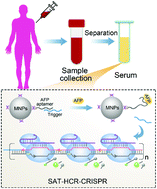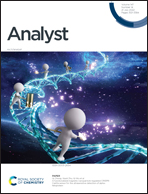A functionalized magnetic nanoparticle regulated CRISPR-Cas12a sensor for the ultrasensitive detection of alpha-fetoprotein†
Abstract
Alpha-fetoprotein (AFP) is an important clinical tumor marker of hepatoblastoma, and the concentration of AFP in serum is closely related to the staging of hepatoblastoma. We report a magnetic bead separation platform based on a switching aptamer triggered hybridization chain reaction (SAT-HCR) and the CRISPR-Cas12a sensor for the in vitro detection of AFP. AFP aptamer, as an easily regulated nucleic acid strand, is responsible for binding to AFP into nucleic acid detection, while HCR-CRISPR-Cas12a, regulated by functionalized magnetic nanoparticles, is responsible for highly specific nucleic acid signal amplification. Under the optimal conditions, the fluorescence intensity was proportional to the concentration of AFP in the range of 0.5–104 ng mL−1 and the limit of detection was 0.170 ng mL−1. In addition, we have successfully applied this biosensor to detect AFP in clinical samples from patients with hepatoblastoma, with greater sensitivity relative to ELISA. Our proposed method showed great potential application in clinical diagnosis and pharmaceutical-related fields with the properties of high sensitivity, low cost and high selectivity.

- This article is part of the themed collection: Analyst HOT Articles 2022


 Please wait while we load your content...
Please wait while we load your content...